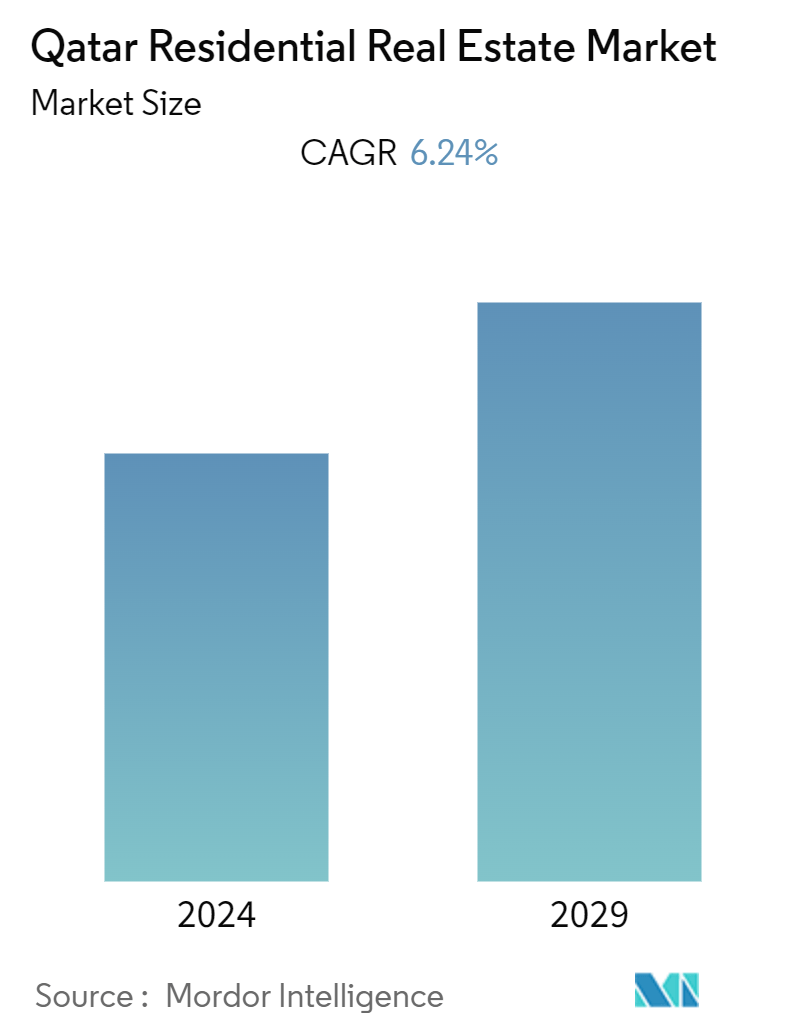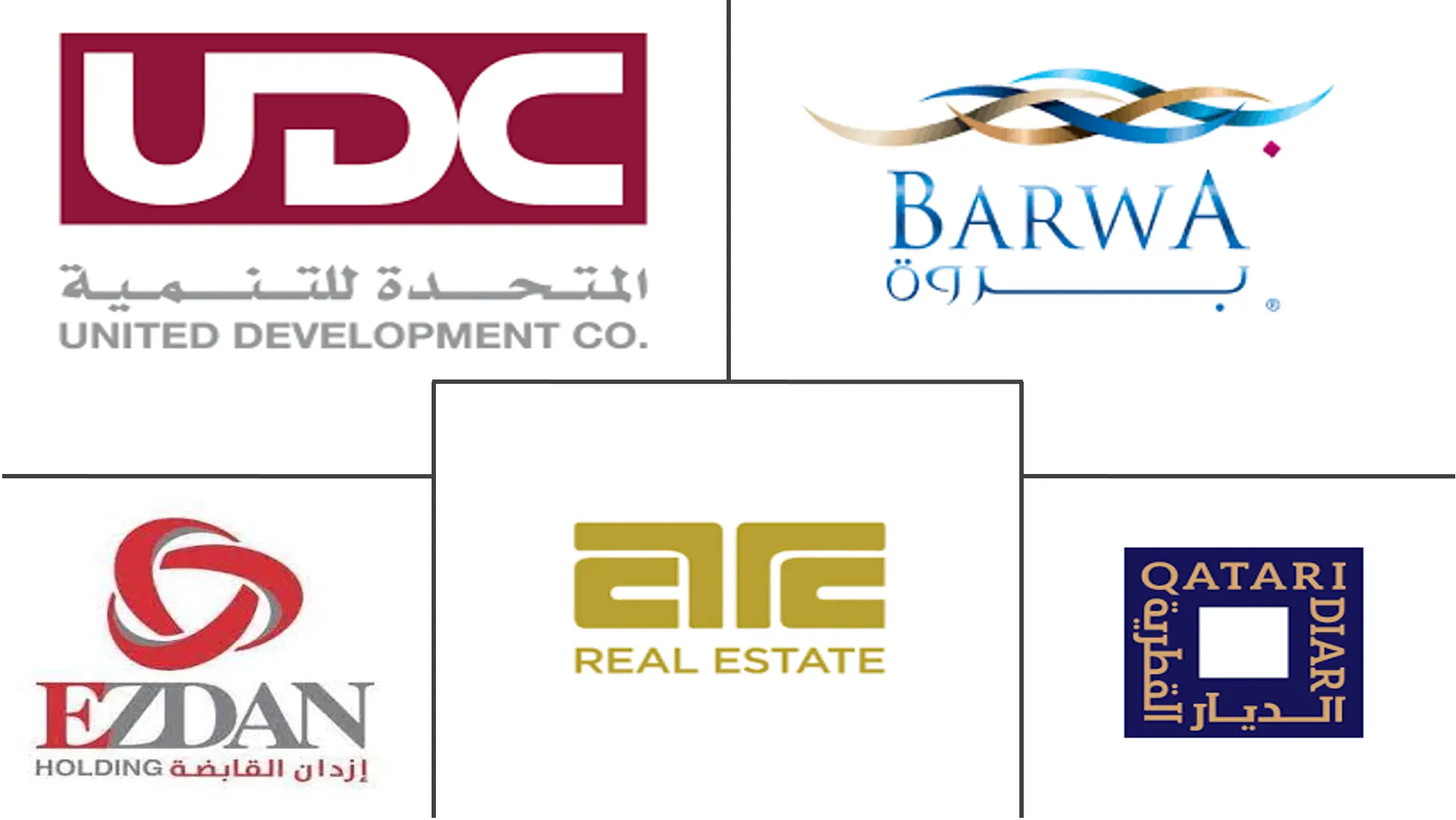Market Size of Qatar Residential Real Estate Industry

| Study Period | 2020 - 2029 |
| Base Year For Estimation | 2023 |
| Forecast Data Period | 2024 - 2029 |
| Historical Data Period | 2020 - 2022 |
| CAGR (2024 - 2029) | 6.24 % |
| Market Concentration | Medium |
Major Players
*Disclaimer: Major Players sorted in no particular order |
Qatar Residential Real Estate Market Analysis
The Qatar Residential Real Estate Market is expected to register a CAGR of 6.24% during the forecast period.
The size of Qatar residential real estate market is USD 4.28 billion in the current year and is anticipated to register a CAGR of over 6.24% during the forecast period
- COVID-19 has negatively impacted the Qatari residential real estate market. Many residential projects were delayed or canceled due to COVID-19. Due to the COVID-19 outbreak and the subsequent collapse of global oil prices, the country's government requested the postponement of more than QAR 29.1 billion (USD 8 billion) in unawarded contracts on capital expenditure projects in April 2020.
- Qatar's economy is one of the thrivings in the Middle East. High GDP growth and population influx, aided by job opportunities and government legislation, are some of the drivers propelling the country's residential real estate market forward.
- The high net worth of the ordinary Qatari inhabitant, both local and expatriate, considerably impacts the construction industry, increasing the demand for luxury and well-organized residential areas.
- The population growth rate, combined with a steady supply of expatriate workers, is expected to generate further demand in the medium to long term. Over recent years, the Qatari government has adopted a series of legislative revisions aimed at preserving the rights of residential building investors in response to rising development activity in the industry.
- Qatar's expanding population, along with a strong demand base and high discretionary income levels, suggests that demand for residential real estate will likely continue to climb in the near future. Despite their wealth, the bulk of Qatar's expatriate population prefers to rent rather than buy. Tightened personal credit restrictions have exacerbated the problem of low homeownership.
- UrbaCon Trading and Contracting (UCC) agreed to build two residential complexes in Al Wakra, Qatar, totaling more than QAR 5 billion (USD 1.37 billion). Al Wakra, a traditional fishing village, is currently Qatar's second-largest city and home to the 40,000-seat Al Janoub football stadium, designed by Zaha Hadid; Al Wakra will be a significant destination for the 2022 World Cup.
- Qatar expects this to serve as a springboard for future expansion, with high-end homes at the center of the city's development. Qatar's Namaa Doha Real Estate firm has broken ground on its 49 high-end villa projects in Giardino Village - The Pearl.
- Construction works on the residential project are progressing at a steady pace, with the project currently scheduled for completion by the end of 2022. The project will also offer investment opportunities at 49 standalone villas, with each villa comprising two levels, a basement, and a penthouse, in addition to a private pool and parking spaces.
Qatar Residential Real Estate Industry Segmentation
Residential real estate is land that has been built for the purpose of allowing people to live there. It cannot be utilized for commercial or industrial reasons. It appears when someone purchases land designated for residential use, which becomes real property and contains a wide range of potential homes, from houses to houseboats, and neighborhoods ranging from the poorest slum to the wealthiest suburban development.
A complete assessment of the Qatari residential real estate market includes an assessment of the economy and the contribution of sectors in the economy, a market overview, market size estimation for key segments, and emerging trends in the market segments in the report.
The report sheds light on the market trends like growth factors, restraints, and opportunities in this sector. The competitive landscape of the Qatari residential real estate market is depicted through the profiles of active key players. The report also covers the impact of COVID-19 on the market and future projections.
The Qatari Residential Real Estate Market is segmented Type (Apartments and Condominiums and Villas and Landed Houses) and by Key Cities (Doha, Al Wakrah, Al Rayyan, and Rest of Qatar). The report offers market size and forecasts for the Qatar residential real estate market in value (USD) for all the above segments.
| By Type | |
| Apartments and Condominiums | |
| Villas and Landed Houses |
| By Key Cities | |
| Doha | |
| Al Wakrah | |
| Al Rayyan | |
| Rest of Qatar |
Qatar Residential Real Estate Market Size Summary
The Qatar residential real estate market is poised for growth, driven by factors such as high GDP growth, population influx, and government legislation. Despite the challenges posed by the COVID-19 pandemic, which led to project delays and a temporary slowdown in demand, the market is expected to recover and expand. The demand for luxury and well-organized residential areas is bolstered by the high net worth of both local and expatriate residents. The government's efforts to protect the rights of residential building investors and the steady supply of expatriate workers are anticipated to further stimulate demand in the medium to long term. The market is characterized by a significant preference for rental properties among expatriates, influenced by tightened personal credit restrictions that have led to low homeownership rates.
The residential real estate sector in Qatar is experiencing a dynamic phase, with ongoing construction projects and new developments contributing to the housing stock. Despite a sluggish market due to the pandemic's impact, supply continues to expand, leading to fluctuations in property prices. The rental market has shown signs of stability, with demand linked to events like the FIFA World Cup 2022. The market is competitive, with major players such as Al Mana Real Estate, United Development Company, and Qatari Diar Real Estate Company dominating the landscape. Foreign investment is expected to rise, particularly in select projects, as non-Qataris are allowed to invest in specific areas. The increasing use of online channels for property transactions reflects the growing internet penetration and rising disposable incomes among the middle-class youth population.
Qatar Residential Real Estate Market Size - Table of Contents
-
1. MARKET INSIGHTS AND DYNAMICS
-
1.1 Current Market Overview
-
1.2 Residential Real Estate Buying Trends, along with Socioeconomic and Demographic Insights
-
1.3 Government Initiatives and Regulatory Aspects for the Residential Real Estate Sector
-
1.4 Insights into the Size of Real Estate Lending and Loan to Value Trends
-
1.5 Insights into Interest Rate Regime for General Economy and Real Estate Lending
-
1.6 Insights into Rental Yields in the Residential Real Estate Sector
-
1.7 Insights into Capital Market Penetration and REIT Presence in the Residential Real Estate Sector
-
1.8 Insights into Affordable Housing Support provided by Government and Public-Private Partnerships
-
1.9 Insights into Technology and Startups Active in the Real Estate Segment (Broking, Social Media, Facility Management, and Property Management)
-
1.10 Impact of COVID-19 on the Market
-
-
2. MARKET SEGMENTATION
-
2.1 By Type
-
2.1.1 Apartments and Condominiums
-
2.1.2 Villas and Landed Houses
-
-
2.2 By Key Cities
-
2.2.1 Doha
-
2.2.2 Al Wakrah
-
2.2.3 Al Rayyan
-
2.2.4 Rest of Qatar
-
-
Qatar Residential Real Estate Market Size FAQs
What is the current Qatar Residential Real Estate Market size?
The Qatar Residential Real Estate Market is projected to register a CAGR of 6.24% during the forecast period (2024-2029)
Who are the key players in Qatar Residential Real Estate Market?
Al Mana Real Estate, United Development Company, Qatari Diar Real Estate Company, Ezdan Holding Group and Barwa Real Estate are the major companies operating in the Qatar Residential Real Estate Market.

